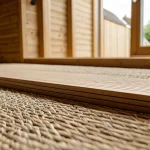Defining Features of British Women’s Fashion
British women’s fashion characteristics are widely recognized for their signature blend of tradition and modernity. This unique fashion element often combines classic tailoring and heritage fabrics with contemporary cuts and bold details. The distinctive British style embraces individuality, encouraging wearers to express themselves through eclectic and innovative outfits.
One of the defining British women’s fashion characteristics is the emphasis on individuality and eclecticism. Rather than following fleeting global trends strictly, British style tends to mix vintage with avant-garde, creating looks that are personal and versatile. For example, pairing tweed with modern sneakers or layering patterns and textures reflects this distinct approach.
Also to see : What Are the Latest Trends in UK Women’s Fashion to Watch This Year?
Moreover, the distinctive British style reflects a practical response to the British climate. The frequent overcast skies and unpredictable weather influence fabric choices and wardrobe staples. Outerwear such as trench coats and knitwear not only serve as functional necessities but also iconic fashion elements rooted in British sensibility. This practical elegance distinguishes British women’s fashion characteristics from more seasonal or temperature-oriented styles seen elsewhere.
Overall, the British women’s fashion characteristics manifest through a balance of heritage appeal and contemporary flair, combined with an unapologetic celebration of personal expression shaped by climate and culture.
Topic to read : What Are the Latest UK Women’s Fashion Trends to Explore?
Historical Influences and Evolution
Insight into the roots shaping today’s British style
The history of British fashion is a rich tapestry woven from various cultural and social movements that decisively shaped its present identity. Early influences stemmed from the Victorian and Edwardian eras, when rigid silhouettes and meticulous tailoring underscored a formal elegance. These periods established the foundation for British women’s fashion characteristics, reflecting social status and conservative values through structured garments and luxurious fabrics.
Moving forward, the 1960s Mod culture profoundly impacted British women’s fashion characteristics by introducing bold colors, geometric patterns, and a youthful, rebellious spirit. This evolution marked a shift towards individuality and eclecticism, traits that remain central in the distinctive British style today. Additionally, punk and other subcultural movements added layers of edge and anti-establishment attitude, pushing British fashion towards innovation while retaining its uniquely British sensibility.
A key pillar in the British fashion evolution is the enduring legacy of Savile Row tailoring. Renowned for its precision and craftsmanship, it symbolizes the fusion of heritage fashion with modern needs. This tradition of bespoke tailoring continues to influence contemporary British style, underscoring the signature blend of tradition and modernity that defines British women’s fashion characteristics.
In summary, the historical trajectory—from Victorian refinement to punk defiance—has cultivated the unique fashion elements that continue to distinguish British women’s fashion today.
Notable British Designers and Icons
British fashion designers have profoundly shaped the global fashion landscape by blending innovation with traditional craftsmanship. Figures such as Vivienne Westwood, Alexander McQueen, and Stella McCartney exemplify the visionary spirit driving the distinctive British style. Westwood’s punk-inspired designs challenged conventions and embraced rebellion, altering the course of British women’s fashion characteristics. McQueen combined theatricality with exceptional tailoring rooted in heritage fashion, while McCartney focuses on sustainability and modern elegance, reflecting the evolution of British fashion.
In parallel, influential British women have become fashion icons whose style choices resonate worldwide. Princess Diana’s approachability and grace introduced a new era of elegance, blending classic pieces with contemporary elements, making her a lasting style reference. Kate Moss revolutionized fashion in the 1990s with her waifish look and effortless cool, embodying the unique fashion elements of British street style and individuality. Alexa Chung’s eclectic and playful approach further enhances the British fashion evolution, bridging heritage with modern trends.
Understanding the perspectives of these designers and icons helps explain the global appeal of British women’s fashion characteristics. Their work consistently embodies the signature blend of tradition and modernity, emphasizing individuality while honoring heritage. Collectively, they reinforce why British fashion designers and icons play an essential role in defining the distinctive British style recognized internationally.
Signature Clothing Items and Styles
British women’s fashion characteristics are vividly expressed through classic British pieces that form the backbone of any wardrobe. Among these, trench coats stand out as iconic outerwear, combining practicality and style to address the British climate’s unpredictability. Originally designed as military garments, trench coats evolved into a symbol of sophisticated resilience and remain indispensable in British women’s fashion characteristics. Alongside trench coats, tweed represents a heritage fabric deeply embedded in the distinctive British style. Tweed’s textured, earthy qualities not only evoke a strong connection to British countryside tradition but also adapt easily to modern styling, underscoring the seamless fusion of tradition and modernity.
Knitwear is another essential component, offering both warmth and versatility in the characteristic British women’s wardrobe. Carefully crafted sweaters and cardigans made from wool or cashmere serve functional needs while enhancing unique fashion elements through various weaves and patterns. The use of plaids, tartans, and distinctive prints further enriches this landscape, contributing to a layered look that celebrates individuality and eclecticism.
Footwear complements these signature clothing items with classic yet practical choices. Chelsea boots, brogues, and wellies exemplify British women’s fashion characteristics by combining durability with design, suitable for urban and rural settings alike. Chelsea boots, with their sleek silhouette, provide a stylish edge that complements both casual and formal outfits. Brogues, characterized by detailed perforations, add a masculine-feminine balance, while wellies offer a playful nod to British weather and countryside culture.
Together, these wardrobe staples highlight how British women’s fashion characteristics incorporate classic British pieces that respect heritage fabrics yet embrace modern practicality and unique fashion elements. This balanced approach enables the distinctive British style to remain timeless, adaptable, and expressive of personal identity.
Patterns, Fabrics, and Textiles
British women’s fashion characteristics are deeply rooted in traditional British textiles, which form a crucial part of the distinctive British style. Among these, Harris tweed stands out as a heritage fabric renowned for its durability and rich texture. Woven from pure virgin wool hand-spun and dyed in the Outer Hebrides, Harris tweed embodies craftsmanship and tradition, serving as a timeless symbol within British women’s fashion characteristics. Alongside Harris tweed, tartan patterns hold a place of cultural significance, closely associated with Scottish heritage yet embraced broadly across British fashion. The repetitive checkered designs and vibrant colors of tartan contribute to the unique fashion elements of British style by adding both historical resonance and visual drama.
Liberty prints, another hallmark textile, bring a distinctly British pattern sensibility through intricate floral and paisley motifs. These prints highlight a softer, more artistic side of British women’s fashion characteristics, often blending seamlessly with more rugged fabrics like tweed or wool to create a balanced, layered look. The skillful mixing of prints and textures is a signature of the distinctive British style, enhancing the eclecticism and individuality that define it.
Wool and cashmere are fundamental to British fabric traditions, prized for their warmth and quality. Wool’s versatility allows for a range of styles, from heavy overcoats to light knitwear, making it indispensable for adapting to the British climate while remaining stylish. Cashmere offers luxurious softness and prestige, often seen in knitwear pieces that elevate everyday outfits with subtle elegance. These materials underpin the distinct British women’s fashion characteristics by combining functionality with aesthetic appeal.
In summary, the melding of heritage textiles like Harris tweed, tartan, and Liberty prints with rich fabrics such as wool and cashmere creates a complex tapestry of texture and pattern. This fusion forms the unique fashion elements cherished in British women’s fashion characteristics, where tradition and innovation meet to maintain a timeless yet contemporary appeal.
Street Style and Contemporary Trends
Exploring British street style reveals how everyday wear reflects the vitality of modern British fashion. Rooted deeply in youth culture and urban influences, London street fashion acts as a dynamic canvas where individuality and eclecticism thrive. This environment fosters the distinctive British style that seamlessly blends heritage elements with cutting-edge innovation.
A hallmark of contemporary trends in the UK is the high-low mix, where designer pieces coexist harmoniously with high-street fashion. This blend allows wearers to express unique fashion elements by pairing exclusive labels with accessible clothing, encouraging personal creativity. It also reflects British women’s fashion characteristics that prioritize adaptability and self-expression over strict adherence to any single trend.
British street style further showcases how global influences are thoughtfully adapted to fit local sensibilities. International trends are integrated but reshaped through the lens of British practicality and climate awareness, resulting in outfits that are both trend-conscious and functional. For example, layering remains essential, pairing statement garments with functional knitwear or tailored outerwear to embody the country’s signature blend of tradition and modernity.
In essence, modern British fashion thrives on this interplay of heritage and innovation, cultivating a street style distinctive for its diversity, boldness, and rootedness in British cultural experience.
Comparison with Other Fashion Capitals
British women’s fashion characteristics stand apart distinctly when compared with styles from other global fashion centers. Unlike the sleek minimalism often associated with Parisian fashion, the distinctive British style embraces a more eclectic and layered approach. Parisian style tends to prioritize refined simplicity and understated elegance, focusing on clean lines and monochromatic palettes. In contrast, British fashion is known for its unique fashion elements, such as mixing vintage with modern pieces and combining bold patterns and textures, which showcases a pronounced celebration of individuality and creativity.
When examining British vs. French fashion, a critical difference lies in how tradition and modernity merge. British women’s fashion characteristics highlight a signature blend of heritage and innovation, where classic tailoring and textiles like tweed coexist with avant-garde designs. French fashion often leans towards timeless chic with less emphasis on heritage fabrics, underscoring a contrast in cultural fashion identity.
The influence of American fashion introduces another comparative dimension. American style is frequently characterized by casual practicality and sportswear dominance, whereas British fashion keeps a strong focus on crafted tailoring and layering suited to its climate. British style reframes global trends through a practical yet artistic lens, adapting influences while holding on to a distinctive British style that is both individualistic and climate-conscious.
Global perceptions of British women’s fashion thus reflect admiration for its bold eclecticism, respect for heritage, and willingness to innovate. This reputation arises from a combination of iconic designers, fashion-forward street style, and cultural layers that shape how British women express themselves through clothing across international scenes.







